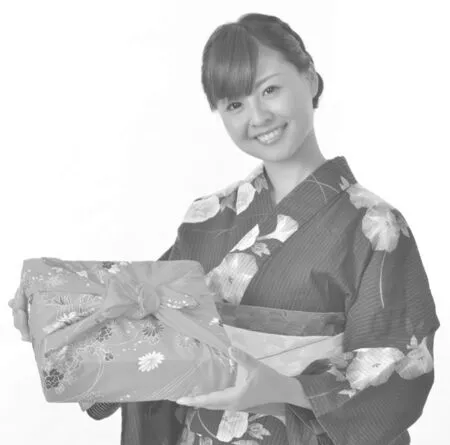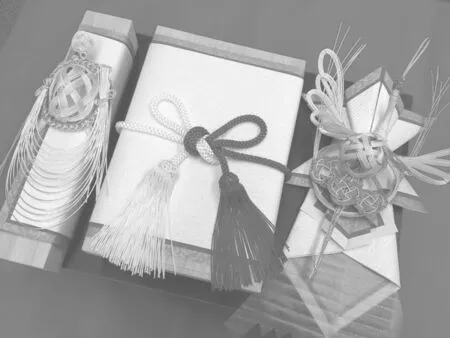日本的礼物文化
文/彼得·范布伦译/蒋威
日本的礼物文化
文/彼得·范布伦译/蒋威

赠礼扎根于日本传统,不仅用于社交,还担负着社会责任——家庭和职场中,受惠于他人时,都要送礼物。礼不在重,关键在送。赠礼方式以及由此体现的周到体贴比礼物本身的价值更有意义。
Gift giving in Japan is deeply rooted in1be rooted in扎根于,来源于。tradition with gifts given not only for social occasions, but also for social obligations—gifts given when indebted to2indebted to感激的,蒙恩于,受惠于。others, both family and business. The emphasis is on the act of giving rather than the gift itself. The value of the gift is of less importance than the presentation and thoughtfulness in which it is presented.
一般赠礼原则
1.礼物得体
[2]日本关于赠礼的书籍琳琅满目,尤其是教人如何挑选一份体面的礼物。最好的办法便是求助,可以问问日本同事、商业伙伴,实在不行,还可以问高级百货商店的店员。礼物太便宜,显得你过于小气;太贵重,又可能让收礼人感到尴尬,增加回礼的压力,因为在日本,赠礼讲究礼尚往来,其意义绝不只在赠礼本身。
General Guidelines
1.Appropriateness
[2] There are shelves of3shelves of大量的(书籍)。books in Japan on gift giving and especially on determining an appropriate gift. The best thing to do is ask for help—a Japanese coworker, business partner or, in a pinch4in a pinch必要时,没有选择余地时。, a salesperson at a nice department store. Too cheap and you look, well, cheap. Too expensive and it may embarrass the receiver and place a lot of stress on him/ her for the reciprocity5reciprocity互惠。requirement, as gifts in Japan are always exchanged, never given per se6per se本身,自身。.
[3]倘若礼物与某个节日或活动有关(比如婚礼),赠礼原则往往就很清楚了。一个字:问!如果是因业务关系送礼物,条条框框就没那么分明了,但地方美食、家乡附近的葡萄酒、运动队的纪念品(尤其是如果队内有日本队员)以及高尔夫球等准保万无一失。收礼人或许不大关心体育,也可能从未打过高尔夫,但真正重要的是送礼物的那份心意。
[3] If the gift is tied to a holiday or event (such as a wedding) there are usually clear guidelines. Ask. If the gift is for a business relationship, the rules are a bit fuzzier, but a local food, wine from near your home, items from sports teams (especially if they have a Japanese player), golf balls, all are pretty safe bets7safe bet准能赢的打赌(或事情)。. The receiver may not care much about sports and may never have been golfing in her life, but it is the gesture that really matters.
[4]一些年长的日本人不喜欢带“四”的礼物,譬如四盒茶。日语中“四”和“死”的发音(shi)相同,因此旧时迷信便开始作怪了。
[4] Some older Japanese will not be happy with gifts that come in fours, such as four boxes of tea. The Japanese word for the number four (shi) can be pronounced the same way as the word for death, and so old superstitions can come into play8come into play开始起作用;开始有(或发生影响)。.
[5]注意:某些商务场合中需要送贵重礼物,比如为了达成一项交易。找人咨询永远是最佳办法。让日方某些合作伙伴了解你有心预先排除可能有损合作的因素,他们会非常开心。
[5] Caution—some business situations can call for9call for要求,需要。expensive gifts, such as the sealing10sealing(以盖章或如同盖章的方式)达成(交易、契约)等。of a deal. Get some advice is always the best idea. Someone on the Japanese side will be very happy to learn you are sorting out11sort out整理,摘出来。anything that might spoil12spoil搞砸。the occasion in advance.
2.包装精美
[6]礼物一定要包装,重要的原则读三遍!
[7]除非送的是花(问问花店老板,有些花和颜色只有葬礼上才用),否则礼物一定要包装,而且不能出错(包装的颜色非常重要)。去高端大气的百货商店买,跟店员说是拿来送人的,说明送礼物的场合,剩下的就交给他们吧,准没错。
2.Wrapping
[6] Gifts must be wrapped. Read it again, and then once more.
[7] Unless you’re handing over flowers (ask the florist, as some colors and plants are used only for funerals), it must be wrapped, and wrapped correctly (colors are very important.) Buy from a large, classy department store, tell them it is a gift and describe the situation, and throw yourself on their mercy13throw oneself on sb’s mercy 请求某人宽恕。. It will work.
[8]为避免彼此尴尬,绝少有人会当面拆礼。某些较为保守和/或年长的日本人,接了礼物,表示感谢后,就会把礼物原封不动地收起来。
[8] Gifts are rarely opened in front of the giver, to avoid embarrassment right then and there to either party. With more conservative and/or older Japanese, the gift will be received, thanked for, and then disappear from sight unopened.
3.礼尚往来
[9]礼尚往来是日本礼物文化中最关键的一部分。除极少数情况外,否则是一定要回礼的。回礼的原则也让人捉摸不透:通常情况下,商务场合中回赠礼物的价值和类型最好与所收礼物相等。而婚礼和葬礼上,回赠的礼物通常只是象征性的。譬如,不知出于什么原因,过去很长一段时间内,出席葬礼的人都会收到一盒手巾作为回礼。如果收到的礼物是钱,几乎不会拿钱来回礼;因为这样看起来就像在退款。
3.Reciprocity
[9] Reciprocity is a final key part of Japanese gift giving culture. With very, very few exceptions, a gift must always be reciprocated. Here again, the rules can be tricky; typically in business settings gifts of equal value and type are best to exchange. For weddings and funerals, the return gift is often more symbolic than anything else. For example, for some reason truly unknown, mourners14mourner 送葬者。at funerals were for a long time given a gift box of hand towels. Gifts of money are almost never reciprocated by giving money; it seems like you are offering some sort of refund15refund 退款。.
[10]很多时候,偏象征性的,尤其是非正式场合下收到的礼物,会以礼品卡来回礼。过去,只有用来换购啤酒和书的礼品卡,但如今,日本与西方一样,任何东西都可以用礼品卡来兑换。如果想保持长期关系,或者有人结婚你送了礼,而你自己又有小孩可能要结婚,那么彼此送了什么东西都得记下来。与送你礼物的人再次见面时,出于礼貌,得向对方表示感谢。未来轮到自己送礼物时,不要送得太便宜或者太贵重,把自己弄得很尴尬。把收到的礼物再转送出去的事曾发生过,没人愿意在这上面出乱子。所以请记下来,你的日本朋友就是这么做的。
[10] Many times more symbolic gifts, especially on more casual occasion, are repaid with gift cards. It used to bethat there were only cards for beer and books, but nowadays, as in the West, there is a gift card for anything. If you expect the relationship to be a long one, or if you gave something for a wedding and have a kid of your own that may marry, records of what things are exchanged are kept. It is polite to thank the giver when you meet again, and you want to not embarrass yourself by going too low on a future gift or too high. Regifting has been known to occur, and you never want to mess that up16mess up 把……搞糟。. Write it down; your Japanese friends do.
4.客套用语
[11]即便不懂日语,送出礼物时试着用日语说几句客套话,也是一种非常礼貌的行为。实在不行,用英语说也可以。
4.Magic Phrases
[11] Even if you don’t speak Japanese, it will be seen as very polite to give some gift giving phrases a try. If you don’t speak Japanese, say them in English anyway.
[12]つまらないものですが就是一句客套话。其字面意思为“一点儿小意思”,但对方知道你只是在客气。不管送的东西值多少钱,大家都会这么说,即使送的是一件达·芬奇的原作。
[12] Tsumaranai mono desu ga is a key phrase. It literally means “this is a boring thing,” but is fully understood to mean that you are being humble, and expressing modesty. People say it no matter what the value involved, even if you are handing over an original Da Vinci.
[13]在职场的某些场合,则会用ほんのお印でございますが,意为“只是聊表寸心”。
[13] However, in some corporate settings, honno o shirushi de gozai masu ga, this is a token of my appreciation, is used.
[14]显然,双方会对彼此说大量谢辞。碰到某些年长的人,“谢谢您/不用谢”之类的话可能要说上数个回合,直到有人停下来。
[14] And obviously, lots of thankyou’s are exchanged. With some older people, you can go multiple rounds of thank-you/you’re welcome until someone fades out17fade out逐渐退出,悄悄离去。.
[15]谨记,呈礼和接礼时都得用双手。尤其对女性来说,接礼前,出于礼貌,至少得推辞一两次。呈礼的时机也很重要。刚一接触就把礼物递上去是一种不礼貌的行为,会让人觉得是在急于套近乎或赶着要走。
常见赠礼场合
[16]以下是几个日本常见的赠礼场合以及各场合下的礼仪和行为规范指南。
Standard Gift Situations
[16] Here are several gift giving occasions in Japan and a guide to the proper etiquettes18etiquette 礼仪,礼节。and mannerisms19mannerism(说话、举止的)习性,癖性。for each of them.
1.纪念品
[17]比如你在日本居住期间去京都过了个长周末,回来时就得给同事、员工、朋友和邻居等人带点“お土産”(小纪念品)。
1.Omiyage
[17] If you take a trip while living in Japan, say, visiting Kyoto over a long weekend, you are expected to bring back to your colleagues, staff, friends, neighbors and the like omiyage, small souvenirs.
[18]日本各县都有自己的土特产,可当作纪念品买来送人。纪念品可以是食品,也可以是具有收藏价值的传统或地方手工艺品。购买纪念品的目的在于,把旅游地独有或有代表性的东西带回去。通过赠送纪念品,收礼人有望从你的旅行中获得一种真实的体验。
[18] In Japan, each prefecture20prefecture(法、意、日等国的)地方行政区域。has its very own local product that can be purchased as an omiyage present. Omiyage could be an edible21edible可吃的,可食用的。or collectible item such as a traditional or local hand craft. The purpose is to bring back anitem that is only available at the place that you travelled to or is specific to22specific to针对;特定于。that place. Hopefully by giving the item, the recipient of the omiyage will have the opportunity to share an authentic experience from your trip.
2.中元岁暮礼
[19]在日本,每年的六月和十二月,同事、朋友和亲戚间通常会互赠礼物。这两个非官方的赠礼节日就叫作中元和岁暮。

2.Ochugen and Oseibo
[19] Twice a year, in June and December, it is common for co-workers, friends, and relatives to exchange gifts. The unofficial gifting holidays are called Ochugen and Oseibo.
[20]中元节(お中元)在每年的7月15日左右,如今仍在盂兰盆节的前两周举行。盂兰盆节是一种祭拜逝者的日本节日。起初,中元礼是一种送给上半年丧亲的家庭的祭品。现如今,中元礼则用于向亲近的人表示感谢,赠送对象通常包括老板、同事、父母和亲戚。食品是一种不错的中元礼。一般来说,广受喜爱的中元礼都是本地工厂或产品代理商生产的,可直接从厂家寄到收礼人手中。中元礼的价格从最低的2000日元到5000日元不等,也可以再高一点。
[20] Ochugen falls around the 15th of July. It originated as an offering to families who had a death in the first half of the year and still takes place two weeks before Obon23盂兰盆节,日语为“お盆”。日本盂兰盆节是一种祭拜先祖神灵的佛教习俗,为期三天。明治初期,日本历法由农历转为公历,各地对这一转变反应不一,造成盂兰盆节有三个举行日期。日本东部,如东京、横滨等地区在阳历7月15日左右举行,与中元节同步。大部分地区在阳历8月15日左右举行,而关东北部、四国等地区则在阴历的7月15日举行。, the Japanese holiday for honoring the dead. Nowadays, gifts are given as a gesture of gratitude to the people who are close to them. Bosses, colleagues, parents and relatives are common recipients. Edible products can be considered as a great Ochugen. In general, the popular products that have been selected as the Ochugen are produced by the local factory or local production agency and can be delivered directly from the factory to the recipient of the Ochugen. The price for Ochugen might vary from aminimum of 2000¥ to 5000¥ and can go higher.
[21]如果说中元是年中赠礼传统的话,那么岁暮便是年末赠礼传统了。岁暮的赠礼日期从每年的12月20日开始。任何食品或饮品都可以作岁暮礼,唯一的区别就是礼签。日文“お歳暮”应写在礼签的顶部。岁暮礼通常送给同事或一年之中悉心关照你的任何其他人。
[21] If an Ochugen is considered as a mid-year tradition, then the Oseibo is the year-end gift-giving tradition. The Oseibo gift giving period begins from 20th of December every year. Any edible product or beverage maybe used for an Oseibo, the only difference will be the Noshi24礼签,日语为“熨斗”,是一种放在礼物上面的折纸,用于表达祝福。. The characters of Oseibo in Kanji25日本汉字,日语为“漢字”。should be written at the top section of the Noshi that is being used for an Oseibo. Oseibo is usually given to people at the work place, and any other person who has had a significant influence for taking care of you during the year.
[22]如今,大量年轻人正在丢掉中元岁暮赠送礼物的传统,所以送礼物前得考虑一下对方的年纪。
[22] Young people are abandoning the traditions of Ochugen and Oseibo in droves26in droves成群结队的。, so consider the age of the person you are considering sending things to.
3.压岁钱
[23]每年的1月1日至1月3日,所有日本成年人都会给小辈一些钱作为礼物。这种礼物传统就叫作“お年玉”(给压岁钱)。通常情况下,无论什么时候,只要大人拜访有小孩的朋友或亲戚,都会给压岁钱。这里需要注意的是,千万不能给硬币,压岁钱只能是纸币。压岁钱要折三次,然后放在一个专门的压岁钱信封里,信封上印有各式色彩鲜艳、漂亮可爱的图案。
3.Otoshidama
[23] At the beginning of a newyear starting from the 1st until the 3rd of January, all adults in Japan will give a certain amount of money to the children or their younger ones as a gift. This gift-giving tradition is called Otoshidama, and is usually given whenever the elders visit friends or relatives’ houses with children. It should be noted here that giving coin is strictly unacceptable, only bank notes are allowed for Otoshidama. The bank note should be folded three times and then put it inside a special Otoshidama envelope that come in a wide variety of colourful and cute pictures.
[24]压岁钱最少得有1000日元,但也取决于收礼人的年纪。年纪最大的小孩通常收到的钱也最多,但现如今,所有小孩收到的压岁钱都一样多,以避免兄弟姐妹间发生不快。据日本公文式儿童研究所称,日本小学生平均每年的压岁钱多达5000日元,而初中生和高中生则多达10000日元!!

[24] The minimum amount of money for Otoshidama should be 1000¥. It also depends on the age of the recipient, the eldest child generally receives the highest amount of money but nowadays all the children get the same amount of money for Otoshidama to avoid any issues between siblings27sibling兄弟姐妹。. According to Kumon2828公文式教育有限公司是由日本公文公先生创建的,现普及于全球四十多个国家及地区,致力培育聪明的孩子。公文式教学法是一种数学与阅读教学法,孩子们通过学习公文式将不断开发自身潜能。children research institute in Japan, the elementary school students in Japan could collect an average of up to 5000¥ while the junior high students and high school students could collect an average of 10000¥!!
赠礼禁忌
[25] 百合花、莲花和茶花都与葬礼有关。任何品种的白色花都是赠礼禁忌。还有一种迷信称,送盆栽植物会让人得病。
Gifts to Avoid
[25] Lilies, lotus blossoms, and camellias are associated with funerals. White flowers of any kind are gifts to be avoided. There is also a superstition that potted plants encourage sickness.
[26]任何跟“四”或“九”有关的礼物都被认为不吉利。但如今这种迷信似乎不那么重要了。
[26] Giving four or nine of anything is considered unlucky29在日语数字中“四”和“九”都被认为是不吉利的数字,因为在日语发音中“四”读作“し(shi)”时和“死”字同音,“九”读作“く(ku)”和“苦”字同音。. This superstition seems to be less important nowadays.
[27]应避免送红色的圣诞贺卡,因为按照日本习俗,讣告通常印在这种颜色的纸上。
[27] Red Christmas cards should be avoided, since funeral notices are customarily printed in this color.
[28] 我并不是说我们每个人都要遵守日本赠礼传统中的所有规则和繁琐的礼仪规矩。你的日本朋友可能真的不在乎这些,但如果你能尊重他们的文化,可能会让他们铭记在心,他们也会更加珍惜你送的礼物。□
[28] I am not saying that every single of us should follow all the rules and complex etiquette of the gift giving tradition in Japan. Your fellow Japanese friends might not really take it seriously but they might be impressed with your efforts to respect their culture and they will most likely appreciate your present even more.
The Culture of Gift Giving in Japan
ByPeter Van Buren
with two hands. Before accepting a gift, especially for women, it is polite to refuse at least once or twice before accepting. The timing of presentation is important. It can be seen as rude to give a gift at the beginning of an interaction. This gesture will be viewed as rushing the relationship or meeting.
“Something old, something new, something borrowed, something blue, and a sixpence for her shoe”
(译者曾获第五届“《英语世界》杯”翻译大赛二等奖)

This was a popular rhyme in Victorian England and has some cultural signi fi cance. It is said that if the bride is given 5 speci fi c wedding gifts to carry with her on her wedding day they will bring her good luck. But what does it mean?
Something old recognises of the continuation of the family line of the bride.
Something new is a look into the future and a celebration of the past.
Something borrowed relates to the borrowing of an item from a friend or family member and signi fi es the support that has been offered to the bride.
Something blue recognises the cultural significance of the colour blue. It is considered to be a colour that stands for consistency, purity and loyalty.
The sixpence in her shoe is a wish for prosperity and good fortune in the future.

